A Nazi tapestry is stored somewhere in the storerooms of the Louvre.
According to
The Art Newspaper
, the museum unwittingly holds a huge 30-square-meter tapestry depicting a heraldic eagle adorned with a swastika.
The object is further stamped with the initials of Adolf Hitler and a quote from
Mein Kampf
: "
Whoever wants to live must fight
".
The wool and silk tapestry is also woven with gold threads which weigh 3.5 kilos.
The origin of this gold questions, while the date of creation inscribed at the bottom of the tapestry is 1942, the year in which the Nazi leaders decreed the "Final Solution" at the Wannsee conference.
Where could the Nazis have found 3.5 kg of gold?
None of the rare official documents concerning the object answer this question, but
The Art Newspaper
considers it possible that it came from the jewels that belonged to the Jews deported to the concentration camps, or even from the teeth of the victims.
Read also: Stolen under the Occupation, a painting exhibited in Verdun to find its owners
The Art Newspaper
investigated how this Nazi object was incorporated into the Louvre collections.
The museum was discreet about this very bulky piece.
But it is now the subject of some media attention.
According to French and American archival documents, the tapestry arrived in 1949 at the American Army's collection point in Munich, where the works moved during the war were collected.
Initially, it was believed that the tapestry had been embroidered in Paris, in the workshops of the Gobelins.
But further research by curator Rose Valland in 1949 concluded that the work came from the factory in Nymphenburg, on the outskirts of Munich.
"
No rights on this work
"
According to a note from Elie Doubinsky, the French representative at the collection point, the 3.5 kg of gold contained in the tapestry had been provided by the Nazi Party.
Once the link with the Nymphenburg factory had been established, he concluded that “
France had no rights over this work
”.
Nevertheless, for some unknown reason, the manager of the collection point, the American Stefan Munsing, had ordered that the tapestry be sent to France.
A surprising decision, knowing that only the works having been spoiled in France should have been returned there.
The tapestry had thus arrived in Paris on June 9, 1949. Shortly after, it was entrusted to the Louvre.
The tapestry does not belong to the Louvre, but it was deposited there as part of the National Museums Recovery (MNR) program, which brings together 2000 works recovered in Germany in 1945. These are objects supposedly coming from France, and whose owners before the war remain unknown, which prevented their return.
The piece is therefore part of the MNR, and yet it did not come from France.
The works of the MNR must be accessible to the public, which “
excludes prolonged conservation
”.
Yet it has never been exhibited and no color photos have been published.
Read also: Acquired by the Nazis, a medieval treasure before the Supreme Court of the United States
In theory, the German authorities could try to claim the coin, but they are unlikely to do so.
Contacted by
The Art Newspaper
, the Louvre referred to the Ministry of Culture, a spokesperson for whom admits that the tapestry "
was sent to France, although it was not created in France
".
A few days after being requested by the specialized media, the ministry discreetly changed the status of the work.
Until a few weeks ago, it appeared in the MNR register as “
looted
”, now it is classified as “
probably looted
”.
The spokesperson explains this modification by the desire to correct an error, the tapestry having made "
no victim
" of looting or forced sale.
Rather than cluttering up the Louvre, the tapestry could instead find its place in a museum dedicated to history, for example the German Historical Museum in Berlin, which contains many Nazi objects.
But it is difficult to imagine that the tapestry will one day be exhibited, due to the glorification of Hitler but also because of its large size.
The work could be destroyed and the gold extracted.
As Stefan Munsing laconically put it in 1949, the tapestry is devoid of "
any artistic value
", its only value "
residing in the golden thread
".
Asked by
The Art Newspaper,
the Ministry of Culture replies that there is "
no question of destroying it
", the tapestry constituting "
an element of history
".

